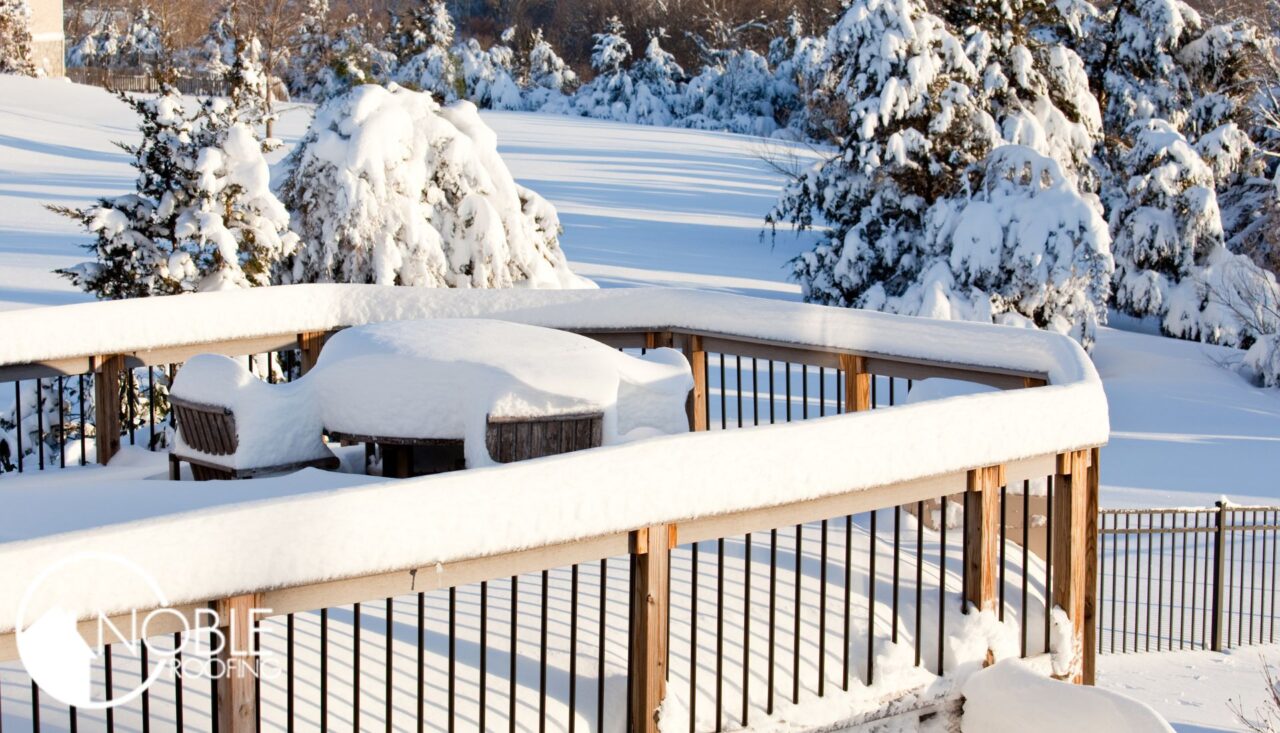Winter can turn a beautiful deck into a slick, dangerous surface, but preventing ice buildup is easier than most homeowners realize. With the right combination of maintenance, treatment, and smart planning, you can keep your deck usable and safe all season long. Here’s a practical, expanded guide that walks through the best ways to stop ice before it starts. At Noble Roofing, we can assist you with your deck’s health by installing Dec-Tec deck membranes, providing a stronger surface that can withstand the forces of winter.
How to Keep Ice Off Your Deck
1. Prevent Snow Buildup Early
Ice usually forms when snow is left sitting long enough to melt and refreeze, so staying ahead of snowfall is your first line of defense. Removing snow during or immediately after a storm keeps moisture from compacting into slippery layers that are tough to break up later. A plastic shovel is ideal because it protects wood and composite boards from scratches or gouges that metal tools can cause. Acting quickly doesn’t just prevent ice—it also makes the job easier because fresh snow is far simpler to clear than partially melted slush.
2. Use Ice-Prevention Treatments
Applying ice-prevention products before temperatures drop is an easy way to stop ice from bonding to your deck. Calcium magnesium acetate (CMA) is widely recommended because it’s effective and safe for both wood and composite materials, making it a great all-around option. Pet-safe or deck-safe melts that use calcium chloride can also help, though you should skip traditional rock salt because it can cause corrosion and surface damage. A light, even application before storms or overnight freezes goes a long way in reducing hazardous buildup.
3. Improve Drainage
Water that can’t drain properly is nearly guaranteed to freeze overnight, which is why good drainage is essential for ice prevention. Making sure your deck boards are adequately spaced and keeping gaps free of dirt, leaves, and debris helps meltwater flow off instead of settling in puddles. Regular seasonal cleaning reduces buildup around posts and corners where ice tends to linger. Even redirecting overly close downspouts can prevent water from dripping or flowing onto the deck and freezing.
4. Add Grit for Traction
When ice does form despite your best efforts, adding grit is a simple way to make the surface safer until you can remove it. Materials like sand, pea gravel, or non-clumping kitty litter create friction underfoot, reducing the risk of slipping during freeze-thaw cycles. While these don’t melt the ice, they offer a practical temporary fix that works well in high-traffic areas. Once the weather improves, the grit can be swept or rinsed away without harming the deck surface.
5. Heated Options
Heated solutions are ideal for homeowners who want a low-maintenance way to keep their deck ice-free all winter. Plug-in heated mats are especially convenient because they melt snow on contact and are designed to be compatible with most decking materials. For new homes or major renovations, built-in radiant heating systems offer a seamless, long-term approach by keeping the entire deck surface warm enough to resist ice formation. Though these systems come with a higher upfront cost, they dramatically reduce winter maintenance and improve safety and comfort.
6. What to Avoid
Some common ice-removal methods can cause significant damage to a deck, so knowing what not to do is just as important as knowing what works. Metal shovels, chisels, and ice picks can scratch, gouge, or splinter deck boards, especially if they’re wood or composite. Traditional rock salt might seem effective, but it can corrode fasteners, discolor decking, and break down the material over time. Torches or open flames should never be used for melting ice, as they present a serious fire hazard and can warp or weaken the surface.
Can Deck Membranes Help with Ice Buildup?
Yes, deck membranes, which we install professionally at Noble Roofing, can help reduce ice buildup, but not by melting ice directly. Instead, they work by stopping the conditions that lead to ice formation. Here’s how:
1. They Improve Waterproofing and Drainage
A high-quality deck membrane prevents water from seeping between boards or into the framing. Because water has fewer places to sit and pool, there’s less moisture available to freeze into ice. This is especially true for waterproof vinyl membranes and under-deck drainage membranes, which route meltwater away from the surface.
2. They Create a Smoother, More Even Surface
Membranes—especially vinyl, PVC, or rubberized coatings—create a uniform surface that sheds snow more easily. Snow is less likely to get trapped in cracks, knots, or uneven board surfaces, which reduces melt-and-freeze cycles.
3. They Reduce Moisture Absorption
Wood decks can absorb meltwater, which later refreezes on the surface. A membrane acts as a barrier that keeps water from saturating the wood, minimizing freeze-thaw expansion and reducing icy spots caused by moisture working its way back out.
Keep Your Deck Ice-Free
Keeping your deck ice-free doesn’t require complicated equipment. You just need a smart combination of prevention, safe treatments, good drainage, and consistent upkeep. By managing snow early, choosing the right melting products, and avoiding damaging tools, you can keep your deck safe, attractive, and functional all winter long. A little proactive effort goes a long way toward turning your outdoor space into a winter-friendly extension of your home.


